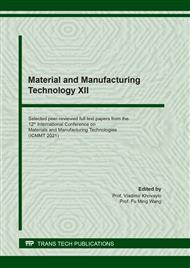[1]
E.V. Bordatchev, A.M.K. Hafiz, O.R. Tutunea-Fatan, Performance of laser polishing in finishing of metallic surfaces, The International Journal of Advanced Manufacturing Technology 73 (2014) 35-52.
DOI: 10.1007/s00170-014-5761-3
Google Scholar
[2]
C.S. Chang, C.K. Chung, J.F. Lin, Surface quality, microstructure, mechanical properties and tribological results of the SKD 61 tool steel with prior heat treatment affected by the deposited energy of continuous wave laser micro-polishing, Journal of Materials Processing Technology 234 (2016) 177-194.
DOI: 10.1016/j.jmatprotec.2016.03.024
Google Scholar
[3]
B. Meylan, I. Calderon, Q.T. Le, K. Wasmer, Investigations of surface defects during laser polishing of tool steel, Procedia CIRP 94 (2020) 942-946.
DOI: 10.1016/j.procir.2020.09.092
Google Scholar
[4]
J. Solheid, H.J. Seifert, W. Pfleging, Laser surface modification and polishing of additive manufactured metallic parts, Procedia CIRP 74 (2018) 280-284.
DOI: 10.1016/j.procir.2018.08.111
Google Scholar
[5]
C. Liang, Y. Hu, N. Liu, X. Zou, H. Wang, X. Zhang, Y. Fu, J. Hu, Laser Polishing of Ti6Al4V Fabricated by Selective Laser Melting, Metals 10 (2020) 191.
DOI: 10.3390/met10020191
Google Scholar
[6]
D. Bhaduri, P. Penchev, A. Batal, S. Dimov, S.L. Soo, S. Sten, U. Harrysson, Z. Zhang, H. Dong, Laser polishing of 3D printed mesoscale components, Applied Surface Science 405 (2017) 29-46.
DOI: 10.1016/j.apsusc.2017.01.211
Google Scholar
[7]
L. Giorleo, E.Ceretti, C. Giardini, Ti surface laser polishing: effect of laser path and assist gas, Procedia CIRP 33 (2015) 446-451.
DOI: 10.1016/j.procir.2015.06.102
Google Scholar
[8]
P. Jaritngam, V. Tangwarodomnukun, H. Qi, C. Dumkum, Surface and subsurface characteristics of laser polished Ti6Al4V titanium alloy, Optics & Laser Technology 126 (2020) 106102.
DOI: 10.1016/j.optlastec.2020.106102
Google Scholar
[9]
H.Z. Zhang, T. Huang, Z. Liu X. Zhang, J.L. Lu, R.S. Xiao, High, fluence nanosecond laser machining of SiCp/AA2024 composite with high pressure assistant gas, Journal of Manufacturing Processes 31 (2018) 560-567.
DOI: 10.1016/j.jmapro.2017.12.020
Google Scholar
[10]
X. Sedao, M. Lenci, A. Rudenko, N. Faure, A. Pascale-Hamri, J.P. Colombier, C. Mauclair, Influence of pulse repetition rate on morphology and material removal rate of ultrafast laser ablated metallic surfaces, Optics and Lasers in Engineering 116 (2019) 68-74.
DOI: 10.1016/j.optlaseng.2018.12.009
Google Scholar


